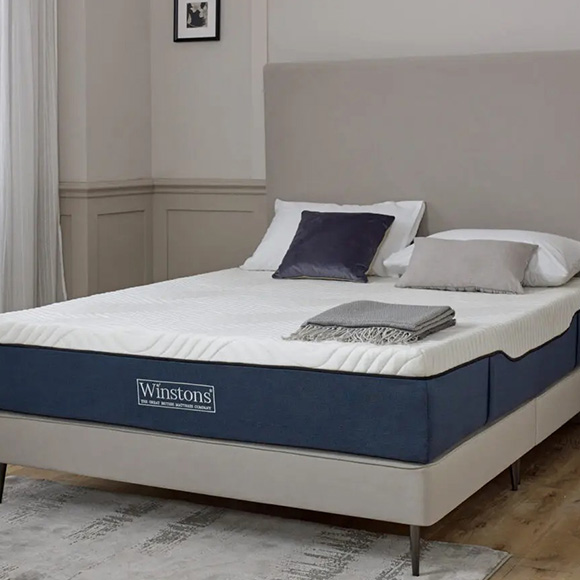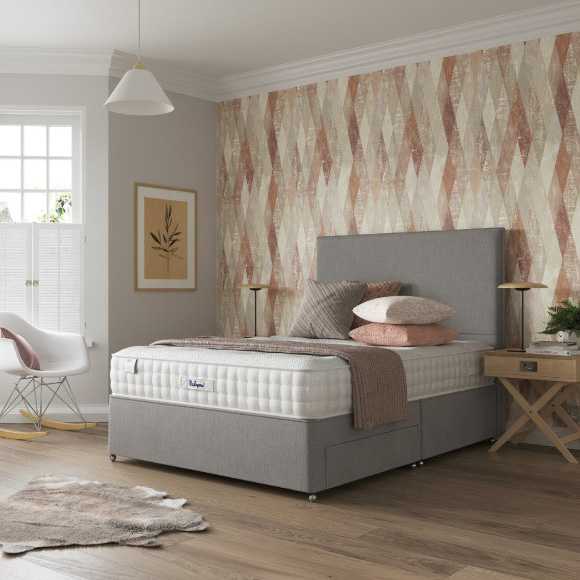Mattress Buying Guide
How can you tell when you need a new mattress?
Did you know, that we will shed over a pound of dead skin cells-a-year whilst asleep? Or that each and every night, we will lose approximately half a pint of fluid in sweat? It may come as no surprise then that it’s widely recommended that we change our mattress every five to seven years. This is both for hygiene reasons, and practical reasons, due to gradual reductions in the mattress’ support.
Otherwise, it’s important to keep an eye out for any signs that your mattress is in need of a replacement, including:
- Poor quality sleep, combined with feelings of fatigue and tiredness throughout the day.
- Regularly waking up in pain, with stiffness or soreness in your back or neck.
- A rise in allergic symptoms. Terry Cralle, a registered nurse and consultant for the American Sleep Apnea Association, has indicated that mattresses will attract allergens, and “as the levels of these allergens increase, so does the risk for problems with allergies and asthma.”
- Finding yourself sleeping better in another bed (and especially the couch), than you do in your own bed.
- Moving during the night, desperately trying to find an adequate, comfortable sleeping position.
- Unevenness in your mattress, caused by wear within the mattress, and resulting in the inability to find a comfortable resting position.
How to choose a mattress
You can’t afford to underestimate the importance of your mattress. Such is your need for high-quality sleep each night, your mattress is often one of your most powerful tools in providing you with vitality and general well-being. And given that you’ll be spending one third of your life on a mattress, it’s enormously important to make sure that it’s perfectly suited to your body, and your needs.
That’s why we’ve put together everything you need to know before you make your decision, including descriptions of what to look for when considering:
- Firmness
- Sleeping position
- Weight
- Back / joint pain
- Mattress type
Of course, despite what some mattress brands may advertise, there is no such thing as a 'perfect’ mattress for everyone. Ultimately, it’s a subjective choice.
Firmness
Your sleeping position, weight and whether you suffer with back or joint pain, will influence the level of firmness you need. Firmness however, is not precisely the same as ‘Support’. Rather, firmness is the initial hard or soft feeling when you first lie on the mattress. How much does the mattress ‘push-back’ on the user? How much does the mattress feel almost like a cloud upon lying on it, or in other words, ‘hug’ the user? Of course, each of these sensations will be subjective, as will the degree to which you’d prefer a softer, more hug-like formation when you sleep, or a particularly firm, push-back formation to the mattress.
Sleeping Position
Side Sleepers
According to The Better Sleep Council, the fetal position (sleeping with your back curved, your head bowed, and your limbs bent and drawn up towards the torso) is the most common sleeping position, preferred by 41% of the population. Other side sleeping positions include the log position (sleeping on your side with your arms down by your side) and the yearner position (sleeping on your side with your arms stretched out).
For those who prefer the side-sleeping position, your hips/shoulders will support most of your weight. A bed that is too hard can cause pain on hips, shoulders, knees, ankles and elbows, and will likely cause your lower back to sag rather than maintain natural, straight alignment.
Your ideal mattress firmness will therefore, likely be in the medium-to-soft range, allowing your hips and shoulders to sink into the mattress just enough to keep your spine straight.
Back Sleepers
A relatively uncommon sleeping position according to the The Better Sleep Council, back sleeping will often contribute to snoring, sleep apnoea, and less-restful sleep, placing most of your body weight on your upper back, bottom, and heels.
Nonetheless, for those most inclined to sleeping on their back, a bed that is too firm and too rigid can cause multiple pressure points, leaving your lower back unsupported, and contributing to muscle tension and pain. A bed that is too soft however, can lack the necessary support, or allow your upper body to sink too far in, contributing to enormous discomfort.
Your ideal mattress is likely in the medium to medium-firm range supporting the natural alignment of your spine, such as memory foam or hybrid mattresses
Stomach Sleepers
The rarest sleeping position, stomach sleeping places pressure on sensitive areas like your chest, face, and elbows. In this instance, a mattress that is too soft can allow your lower back to sag downward or place added tension on your neck. But, a mattress that is too firm can also cause pain and pressure points.
Your ideal mattress is in the medium-firm range.
The pillow you use will also affect your sleeping position and back alignment, so make sure you pick one that suits your particular needs. Take a look at our Pillow Guide to find out more.
Weight
How much you weigh can play a role in mattress comfort, as gravity will cause heavier sleepers to have a different experience than smaller people.
Petite: People that are very thin or lighter than average often prefer softer beds. This is because their lighter weight may reduce contouring, and they may also have less natural padding around pressure points.
Heavier: The heavier you are, the firmer the mattress should be. People who are over 15 stone often finding memory foam as the most comfortable.
Back or Joint Pain
If you suffer with back pain or joint pain, sleeping on the wrong mattress can either lead to, or worsen pain. Therefore, make sure your mattress provides proper support, spinal alignment and pressure point relief. This will address persistent upper and lower back pain as well as shoulder and neck pain.
The old adage that ‘firmer is better’ may not now be accurate. Studies have found that that medium-firm mattresses are more effective at relieving chronic low back pain than firm mattresses. Based on everything we've looked at, medium-firm memory foam mattresses seem best for those suffering back pain, as they have higher ratings for pain relief compared to spring beds. Generally, high density foam (5 lbs+) provides the best support and optimal spinal alignment.
Mattress Type
Among consumers, there are two types of mattresses that stand out: pocket sprung and memory foam. At first glance these two mattresses provide the best comfort, support and quality on the market, and it seems you would be hard-pressed to find a better option out there. However, there are a few key differences between pocket sprung and memory foam mattresses and knowing what these are is crucial in helping you choose the one that’s right for you.
Pocket Sprung Mattress
- Popular traditional type of mattress made from individual, small springs housed in separate pocket of fabric.
- Good option if you’re looking for a bed for two people, as the springs move independently to cater for your different weights and minimise the risk of you rolling towards your partner during the night. Any sleeping position can be supported.
- More breathable than memory foam so ideal if you’re always getting too hot during the night.
- Will require turning and are heavier than other types of mattresses.
- Can be filled with natural materials such as wool which is a natural regulator of temperature.
- Go for mattresses that have 1,000 springs or more - anything below that is considered low quality. The more springs, the firmer the mattress.
- Best for those sleepers who prefer a springy feeling, as opposed to a sinking one.
Memory Foam Mattress
- Made from memory foam, which contours to the shape of your body, easily absorbs your weight, provides immense support and relieves pressure on your joints.
- Many of the new, more advanced foams are designed with superior cooling properties, creating mattresses more capable of temperature regulation.
- Hypo-allergenic with anti-microbial properties.
- Ideal for those who need support, or suffer from a bad back, as it cradles the body’s curves whilst supporting the back’s muscular and bone structure, whatever position you sleep in.
- Memory foam isolates movement, reducing noise from tossing and turning in bed.
- Best for those sleepers who want a pronounced ‘hug’ feeling from their mattress.
Hybrid Mattress (IE. Pocket Sprung & Memory Foam)
- A combination of pocket sprung and memory foam.
- Provides a contouring feel to the body, similar to that of a memory foam mattress, but to a lesser degree.
- Due to their pocketed coil support core, hybrid mattress are bouncy, yet their foam comfort layer offers good motion isolation, so sleepers aren’t disturbed by others getting up or shifting positions in bed.
- Can stay cool throughout the night (more so than memory foam and latex mattresses), as they are less likely to trap heat, and regularly incorporating cooling gel layers.
- Best for sleepers who want the best of all worlds.
Best Mattress Brands 2024
Winstons
Winston’s mattresses and beds are made by artisans with over 90 years of British handcrafting heritage, giving them a fair amount of experience to draw from! Winston’s founders made it their mission to supply customers with the highest quality products in the world at the most reasonable prices.
Mattressman
Established in 2004 Mattressman was one of the first online bed mattress companies to offer their customers Free Next Day Delivery anywhere across the UK…revolutionising the online mattress industry. Now we are recognised as one of the UK’s cheapest retailers for mattresses, beds and accessories.



